Would you like to have a peek into a craft workshop? Our today’s guest will give you such an opportunity. Bonnie Scorer, a mother of three, a former educator and a very creative person (and the one who inspired me to make autumn felt leaves), is going to share her secrets of planning crafts, arranging materials and getting children involved. She is also going to prove the axiom that creativity runs in families and passes from generation to generation. Meet Bonnie, the author of the website “Make It Your Own”.
Olga: Bonnie, I'm happy to have you as a guest.  I'm sure our readers will be interested in your background. So, will you tell us a few words about yourself, your family, your profession and the country you're currently living in?
I'm sure our readers will be interested in your background. So, will you tell us a few words about yourself, your family, your profession and the country you're currently living in?
Bonnie: I am a mother of three young children. Aside from taking care of them, our family has a children's website called make-it-your-own.com. The purpose is to provide families with starting points of activities to do together. My husband's background is in digital media and I was an educator, so it is a combination of our family's enjoyment to create. We live in Canada, although my husband has travelled quite a bit and we are always so impressed with many Europeans’ abilities to speak multiple languages!
Olga: What ages are your children? Are you a homeschooling mum?
Bonnie: Our children are 1, 3.5 and 6 (they are each 2.5 years apart.) Our older children attend a small school which has a lovely community feel to it. Depending on the province, many children attend pre-school programs, Elementary school starting at 4 or 5 and the Middle School or Junior High at ages 11 or 12 and then high school at 14 or 15 until they are approximately 18. However, there are many variations of schools based on languages that instruction is taught in, religious or cultural programs, interest based (Arts schools for example) etc. There are families that chose to home-school or some that do this in conjunction with a school board either by attending a school part time or through online programs.
Olga: Well, you know it looked to me as though the majority of craft blogs in English are run by either homeschooling mums or preschool teachers. Frankly speaking, your answer that two of your children attend school surprised me. Mostly because of the number of crafts and ideas one can find on your blog. Bonnie, how do you find so much time for crafting with your older kids if they have to be taken to and from school on a daily basis and the one-year-old is around?
Bonnie: One of the older kids only goes to school for half of the day. Often times we collaborate on projects. So for example my daughter and I might paint something that my son then draws on for another step. (So there are many projects on the go at once!) Aside from reading and playing at the park and in our playroom, making stuff takes up much of the kids’ free time (especially with the long winters in the area of Canada that we live in). With a one year old, we mainly wait to take photographs of the projects on the weekend while he naps. Although given the chance, he loves to get his hands on a paintbrush too! Our hope with the website is that we inspire families to do things together, to re-imagine (recycle) items and to get out into nature.
Olga: You certainly succeed in that – and not only other families but teachers too. As one of the inspired by your creativity, I can say that it is contagious. 
Bonnie, how do you usually decide you should start on a certain project? Do your crafts typically come as part of the theme you're studying at the moment with your children? Or do they arise from a desire to give someone a handmade present? Do most of your craft ideas belong to you or the kids?
Bonnie: Thank you for the positive feedback! The ideas for the activities spring from many sources – some are thematic or celebration based, some are based on gifts we want to make for specific people and others come from an inspiration of a material that we have received. Some of the ideas are processes that I would like to expose the kids to and others are things that mainly our eldest son has thought up. Sometimes they are a collaboration of the two of us and his sister is quite eager to be involved (She is beginning to come up with her own ideas too.).
We try to have a range of activities to appeal various age or ability groups, with a differentiation on complexity (so some things that could take 20 minutes and others that might involve a few sessions) and a variety of materials (so some that involve things that are more readily available and others that use specific materials or tools). Two of our other goals include re-imagining/ recycling items and going outdoors, so that factors into some of our project choices as well.
We keep a plan of potential future activities for the year ahead, try them out and include the ones that we think might appeal to others. Some activities span over a significant amount of time (for example our son has been working on a machine since the summer, collecting specific things to create it) and others might be something that just pops into our heads.
Both my husband and I have mothers who worked with children professionally and in a volunteer capacity so some of the ideas draw on our own experiences growing up – things that we did at home or with groups of children in various settings. We try to add our own touch/interpretation. Both of the families that we came from enjoy various forms of creating which has influenced what we do as a family together.
I loved my time as an educator and this is way to continue to contribute to the lives of children.
Olga: Ah, here is where it comes from: from your mothers! A love of creativity (or of anything else, in fact) instilled in a person during their tender years, is most deeply rooted. And I guess the belief “I can create it with my own hands” is one of the most precious gifts parents can give to their children.
Bonnie, I’d like to appeal to your experience. What is rule number one for instilling love of handmade things into kids? And what do you think is the wisest thing for parents to do when children don’t want to get involved?
Bonnie: I think that if you value things that are handmade that this often translates into your child's appreciation. I think that the question, "What do you do with the child who is reluctant to engage in this type of activity?" is relevant to children in general. When I was an educator I tried to approach this in these ways:
- Have a positive, excited attitude. When we were studying something, I tried to develop interesting projects that connected to the children's knowledge, experiences and interests. Each year I would share some of the projects that previous students had done and this also translated into them seeing that their peers were engaged and that there was a wide range of ideas from very different students.
- Try things that are open-ended so that children can be involved in various ways. So for example when I taught art and we were working on foreground, middle ground and background and we did a project that folded out students made race cars with fans in the stands, haunted houses, rain forests etc. The students could explore the concept with something that interested them.
- Provide supplies and make them appealing. This might include having a small table in your home or classroom with exciting materials that you rotate and ways to invite the students to get involved (e.g., various lines drawn on paper – "What could you turn this into?"). I learned from my mother-in-law (a long time play school teacher), to arrange the materials rather than just leaving them in containers so kids can see and access them easily.
- What I always liked about teaching art or working on projects at home is the conversation. I would often play music for the students to work to and they could converse/collaborate with their classmates. This differed from when they might be working on a science project where the conversation centred mainly on the topic at hand, whereas during art they had more free conversations as long as they were being productive.
- 5) Display the work. I tried to always display the children's work in an interesting manner so that the students could be proud of their creations and that the next year's students could get excited about potential future projects. Our children's projects are in our home and they enjoy giving them to teachers, family members etc.
- Follow your child(ren)'s interests. Our daughter loves bunnies, so in the summer mornings we would get out pairs of binoculars and go for walks in our community on the look out for bunnies that come up into the neighbourhood from the nearby wooded area. We'd take rabbit books out of the library and provide related toys for imaginary play. If your child likes trains - try to go on a train ride, attend a train museum, watch a film on trains. Of course every family is not going to be interested in making things, but we try to provide a range of activities so that they might experiment and try something new.
This has been a great experience Olga – and has prompted me to articulate our thoughts further. Thank you!
Olga: Great tips! Bonnie, thank you for sharing your ideas and experience. It has been interesting speaking to you. 
Bonnie: It was a pleasure talking with you and your readers. Here are a few studio photos:
- Our walls are lined with shelves where we keep basic supplies on top and then the materials for specific projects underneath. We also store surfaces (that work as a background) behind, although we typically use a rustic board as our favourite. We have a craft room in our basement where we keep various supplies and a table for the children to work on their projects.
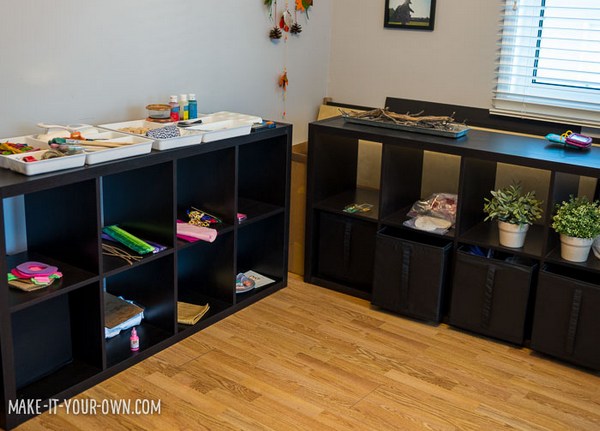
- Our littlest getting into the upcoming project supplies:
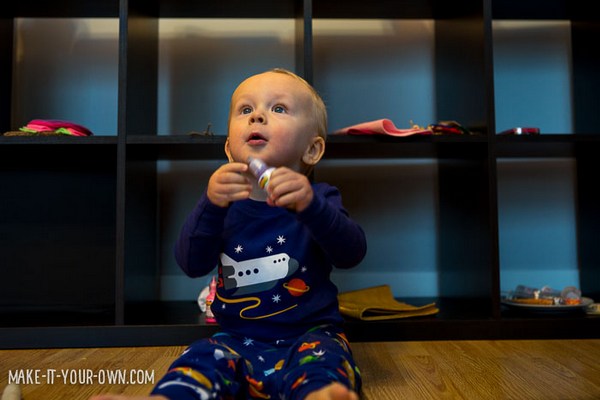
- For shooting the photos themselves, we use a surface in front of a large window. Although in the winter now, we often have to use more than the natural light which is our favourite for the photographs.
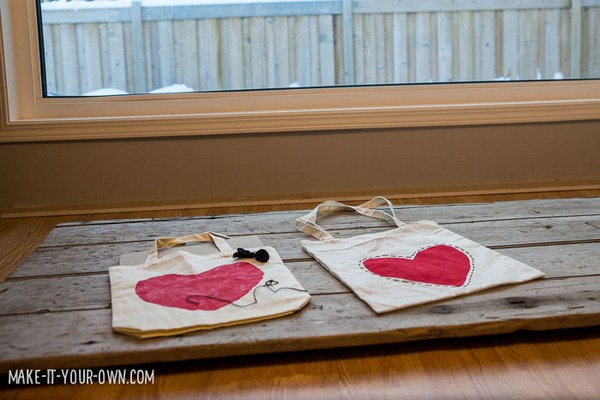
- Supply Photos:
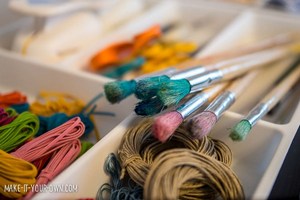
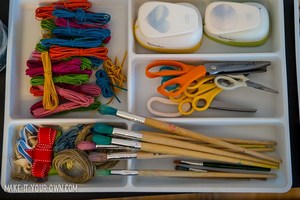
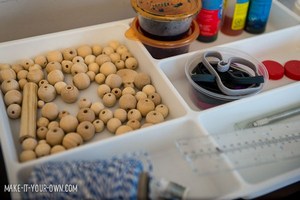
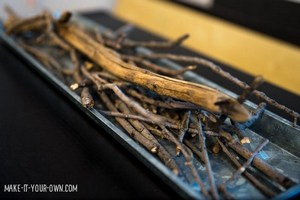
- Our children:

Olga: Bonnie, thank you for providing such great photos that give us an opportunity to peek into your workshop.

Thank you so much for sharing our story with your readers Olga! We quite enjoyed connecting with you and hearing about your work with children as well.
Sincerely,
The Scorers-
Thank you for the conversation, Bonnie.
I showed the pictures you sent me to my daughter and she asked me to read the whole interview to her, which I did. She listened very attentively and decided to borrow some of your ideas, such as keeping a list of future crafts and lining basement walls with shelves. So the interview has definitely been useful to us.
And we're certaintly going to sew your peek-a-boo hearts for St. Valentine's Day.
Bonnie, thank you for sharing your craft ideas and sharing your heart. Some of the tips are very helpful for me. I don't have a basement with a craft room, but I think I need to be more organized with my craft supplies.
Bonnie, thank you for a great many of ideas! I will definitely rethink the availabilty of craft supplies in our house, and will try find more time for crafting as this is indeed something invaluable, the love for it, we can translate to our childen at this tender age